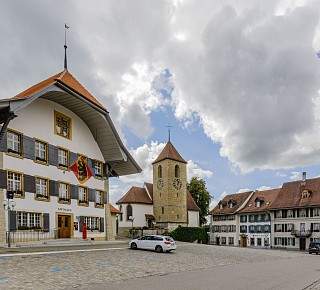Outdoor activities
The Lamberta caves - the natural playground for children
The caves above Môtier were dug between 1916 and 1917 during the First World War to defend the Swiss Plateau. The tunnels carved into the sandstone reach an impressive length of 200 metres and are now a paradisiacal playground for children; little explorers explore every corner or play hide-and-seek for hours. Important: don't forget your torch! There is a lovely barbecue area in front of the caves.
For visitors interested in history, there is the opportunity to walk along historic paths on Mont Vully and to explore various bases from the First World War. In September 1914, around 16,000 militiamen built the fortifications in the Murten area (Zihlkanal, Mont Vully and Murten–Laupen).
St Peter's Island on Lake Biel
This «island» has had a colourful past and is still very much enjoyed today. Initially it was a prehistoric settlement, then a Roman site, a center of power for the Burgundy, a sanctuary for Jean-Jacques Rousseau, and now it is a romantic and restful destination for locals and tourists.
You can get to the island from the medieval town of Erlach. There is a nice walking track or alternatively a little taxi-boat «Navette» that takes you close to the restaurant. There are scheduled boats but check with the hotel for the timetable.
Aarberg
After a disastrous fire, Aarberg has been rebuilt in 1477. Between the two rows of houses, a marketplace has become the main attraction. Aarberg was given the market-rights for salt, iron and cloth, which led to a certain economic wealth. In 1798 Aaberg was occupied by Napoleon’s troops.
Avenches
At the time of the Romans the site was called «Aventicum» and it was the most significant Roman settlement on what is todays Switzerland. It served as a transit place on the way from the Rhone-Valley to Germany. The Roman ruins, the Roman Museum, the historic old town plus the cultural events in Avenches offer a variety of historical and leisure activities.
Bern
The capital of Switzerland was founded by the Duke of Zähringen in 1191. Berne is listed as an UNESCO world heritage. The medieval old town has a very unique charm, here you can explore the streets without fear of getting too lost as the river will always guide you. Thanks to its alcoves in the main street Bern is also called the biggest shopping center of Europe. You can hop from shop to shop without getting wet in the rain. The main sites are the «Bundeshaus» (House of Parliament and Government), the «Zeitglocken-Turm» (Clock Tower), the «Käfig-Turm» (Prison-Tower), the «Bären-Park» (Bear-Park – the bear is the city’s mascot) plus many cultural institutions such as the Paul-Klee-Center, the Museum of Fine Art, etc.
Biel/Bienne
This bilingual city (the biggest in Swizerland) is considered the main center of the Swiss watch industry. Here you will find the headquarters of the Swatch Group and production centers for Rolex. Other important watch centers are Le Locle, La Chaux-de-Fonds and Grenchen – all close to Biel/Bienne.
It also offers a very well-maintained old town which is certainly worth a visit.
Estavayer-le-Lac
It is said that this city was founded in the 12th century by the Bishop of Lausanne. As of 1245 the city belonged to the Duchy of Savoy. In the process of the wars with Burgundy, the city was conquered by the Swiss in 1475. In 1600, the plague (black death) dramatically reduced the population of Estavayer. The medieval old town has national significance and the city wall from the 13th century is still partially visible. It is guarded by four towers and gates.
Freiburg/Fribourg
If you have visited Bern, you will find many similarities as both cities were founded by the Duke of Zähringen. Freiburg (in French Fribourg) was founded in 1157 on a strategically ideal location overlooking the River Saane. Its well maintained and still populated old town is spectacular. Not to be missed is the Cathedral of Saint Nicolas. It was constructed in several stages, building started in 1283 and finally finished in 1490.
Grandson
Grandson has a very long history as a settlement. The earliest sign of human habitation goes back to the Neolithic Age (New Stone Age). Better known are the «palafittes» along Lake Neuchâtel, these go back to the time period of 3.000–1.200 B.C. Grandson is a picturesque medieval old town, and the main attraction is the Castle of Grandson that dates back to the 13th century. Grandson was the first of three major battles between the army of the Duke of Burgundy and the Swiss Confederation (the other two being Murten and Nancy).
Neuchâtel/Neuenburg
The first history of the city goes back to the year 1011 when the King of Burgundy Rudolph III, offered the «Novum Castellum» (the new Castle) to his wife Irmengarde. The major attraction of the city is the Castle with its church (La Collégiale). The city is by the lake making it easily accessible by boat, and even if you arrive by car or train be sure to take a walk along the front. Also while you are there, a visit to the Centre Dürrenmatt is highly recommended.








